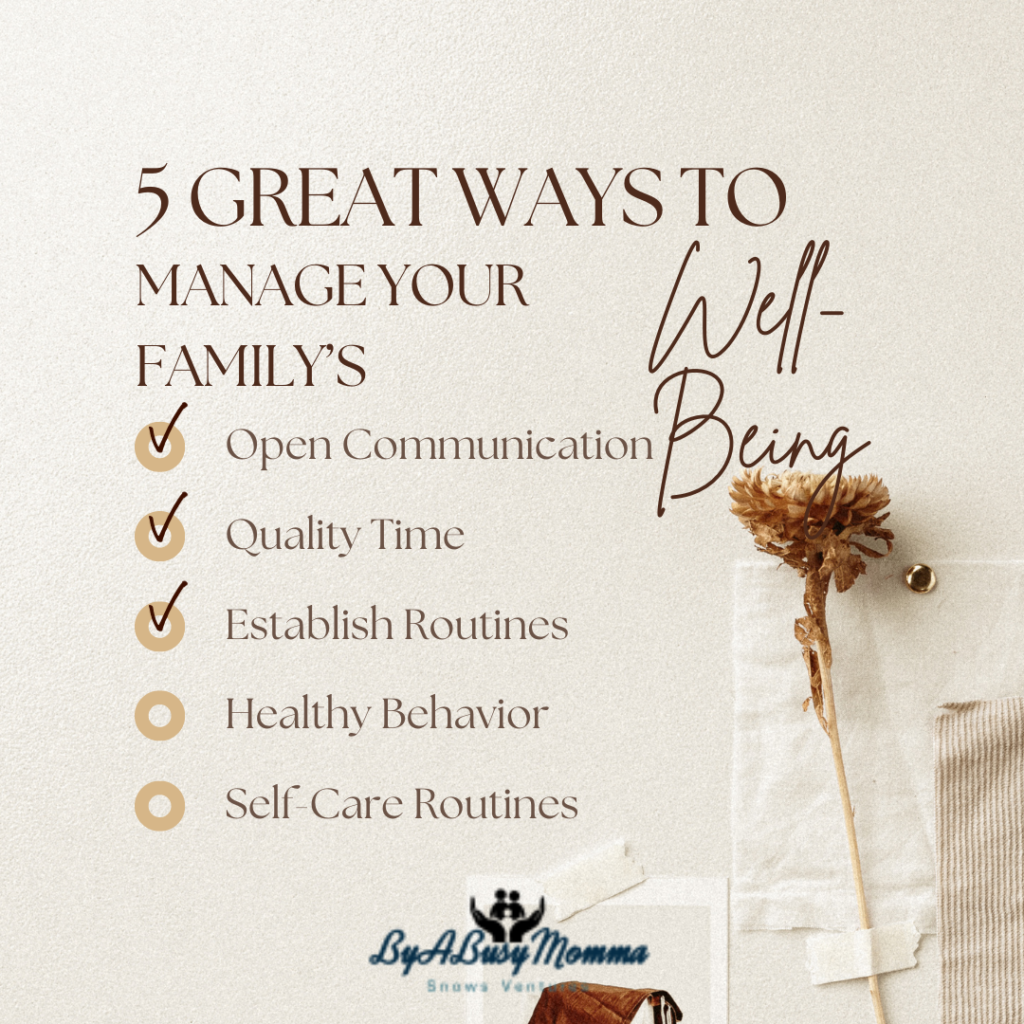Managing your family’s well-being is essential for creating a healthy and balanced environment within your home. Here are five great ways to help you prioritize and manage your family’s well-being- open communication, quality time, establishing routines and boundaries, promoting physical and mental health, and practicing self-care.
Check out these great tools on Amazon as well:

1. Open Communication:
- Foster a culture of open and honest communication within your family.
- Encourage each family member to express their thoughts, feelings, and concerns without fear of judgment.
- Regularly check in with one another to address any issues that may arise and work together to find solutions.
2.Quality Time: Dedicate regular quality time for connection with your family. This can involve engaging in activities together, such as family meals, game nights, outings, or shared hobbies. Spending quality time together strengthens relationships, promotes positive emotions, and creates a sense of belonging.
3.Establish Routines and Boundaries: Setting up routines and boundaries helps supply structure and stability for your family. Set consistent bed and mealtimes and establish rules promoting a healthy and balanced lifestyle. Respect each family member’s need for personal space and downtime, and teach children the importance of respecting boundaries.
4.Promote Physical and Mental Health:
- Prioritize your family member’s physical and mental well-being.
- Encourage regular exercise and physical activity by participating in walks, bike rides, or sports.
- Promote a balanced diet and healthy eating habits.
- Support mental health by creating a supportive environment where emotions are acknowledged and seeking professional help is encouraged when needed.
5.Practice Self-Care: Remember that caring for yourself is crucial for managing your family’s well-being. Prioritize self-care activities that help you recharge and maintain your physical and mental health. This might include hobbies, exercise, journaling, or spending time with friends. By prioritizing your well-being, you become better equipped to support your family members.
It’s important to note that each family is unique, and what works for one may not work for another. Please customize these strategies to fit your family’s specific needs and dynamics. Regularly assess and adapt your approach to ensure it aligns with your family members’ changing needs and priorities.

Here’s some more information on managing your family’s well-being:
Encourage Emotional Intelligence:
- Teach your family to recognize and manage their emotions effectively.
- Help them develop empathy, active listening, and problem-solving skills.
- Encourage open discussions about emotions and provide a supportive environment for expressing feelings.
Foster a Positive and Nurturing Environment:
- Create a positive and nurturing atmosphere at home.
- Show appreciation, offer praise, and celebrate achievements.
- Encourage a growth mindset, where mistakes are seen as learning opportunities.
- Create a safe space where family members feel comfortable being themselves and expressing their thoughts and ideas.
Support Individual Growth: Recognize and support each family member’s growth and interests. Encourage personal goals and provide resources or opportunities for learning and development. This can involve supporting educational pursuits, hobbies, or extracurricular activities that align with their interests and passions.
Manage Stress:
- Help your family members develop healthy coping mechanisms.
- Encourage healthy outlets for stress reduction, such as engaging in physical activities, hobbies, or creative pursuits.
- Journaling is another excellent tool for managing stress.
Financial Well-being:
- Promote economic well-being within your family.
- Teach children about financial responsibility, budgeting, and saving.
- Involve the family in financial discussions and decision-making to foster a sense of financial literacy and responsibility.
Cultivate Strong Relationships:
- Encourage solid relationships and connections within your family.
- Help family members develop positive relationships with one another by promoting empathy, respect, and effective communication.
- Encourage siblings to build strong bonds and create opportunities for family members to support and care for one another.
Seek Support: Recognize that managing your family’s well-being is not solely your responsibility. Reach out for support when needed. This can include seeking advice from trusted family members or friends, joining community groups, a church, or support networks, or seeking professional help from therapists or counselors.
Lead by Example: As a parent or guardian, your behavior sets an example for your family. Model healthy habits, emotional intelligence, and self-care practices. Show vulnerability, apologize when necessary, and demonstrate resilience in facing challenges. Your actions will have a profound impact on the well-being of your family.
Remember that family well-being is an ongoing process that requires continuous attention and effort. Regularly assess and adapt your strategies to meet the changing needs of your family members. Communication, understanding, and a supportive environment are vital to creating a thriving and happy family unit.

Creating a positive and nurturing atmosphere at home is crucial for the well-being and happiness of your family members. Here are some tips to help you foster such an environment:
Show Love and Affection: Express love and affection towards your family members through words, gestures, and physical touch. Offer hugs, kisses, and verbal affirmations of love and appreciation. Small acts of kindness and thoughtfulness can go a long way in creating a nurturing atmosphere.
Practice Effective Communication:
- Foster open and honest communication within your family.
- Encourage active listening, where each family member feels heard and understood.
- Create a safe space where everyone can express their thoughts, feelings, and concerns without fear of judgment.
- Encourage respectful dialogue and resolve conflicts positively and constructively.
Create Family Rituals: Establish regular family rituals or traditions that unite everyone. This can include weekly family meals, game nights, movie marathons, or outings. These shared experiences create a sense of belonging, strengthen family bonds, and provide quality time and connection opportunities.
Encourage Mutual Support:
- Foster an environment where family members support and uplift one another.
- Teach the importance of empathy, compassion, and kindness.
- Encourage siblings to help each other and promote teamwork and collaboration in family activities.
- Celebrate each other’s achievements and provide support during challenging times.
Cultivate a Positive Mindset:
- Foster a positive mindset within your family by focusing on gratitude and appreciation.
- Encourage family members to express gratitude for the good things in their lives.
- Create a culture where positive attitudes, resilience, and optimism are valued and reinforced.
Set Clear Expectations and Boundaries: Establish clear expectations and boundaries within your family. Communicate values, rules, and responsibilities. This helps create structure and stability, reducing conflicts and misunderstandings. Ensure that expectations are reasonable and age-appropriate for each family member.
Encourage Individuality and Autonomy:
- Respect and nurture the individuality and autonomy of each family member.
- Encourage their unique interests, talents, and goals.
- Support their personal growth and provide opportunities for self-expression.
- Celebrate their achievements and encourage them to pursue their passions.
Practice Active Problem-Solving: Teach your family members problem-solving skills. Please encourage them to approach challenges with a positive mindset and view them as opportunities for growth. Help them brainstorm solutions and make decisions together as a family. This fosters a sense of empowerment and builds resilience.
Create a Calm and Safe Physical Environment:
- Ensure your home environment feels calm, safe, and welcoming.
- Maintain cleanliness and organization to reduce stress and create a sense of tranquility.
- Provide personal spaces where family members can retreat and relax when needed.
Lead by Example: As a parent, be a role model for the positive behavior and attitudes you want to cultivate in your family. Demonstrate kindness, respect, empathy, and resilience in your actions and words. Your behavior sets the tone for the overall atmosphere at home.

Remember that creating a positive and nurturing atmosphere takes time and effort. Be patient, adaptable, and responsive to the needs and dynamics of your family. Regularly assess and adjust your approach to ensure it aligns with the well-being and happiness of your family members.
